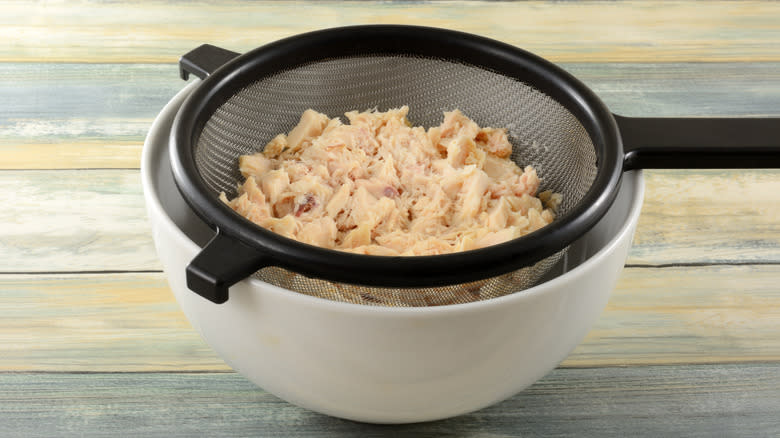Does Canned Tuna Need To Be Rinsed Before Eating?

Rich in protein, canned tuna is a favorite snack among athletes and gym-goers. You can eat it as is, mix it with veggies, or serve it with rice, pasta, potatoes, or eggs. For example, this Southwestern tuna and rice salad is ready in less than 20 minutes and makes a filling lunch or dinner. But if you're craving a warm meal, add tuna to casseroles, beef chili, poke bowls, or omelets.
A can of light tuna in water has around 220 calories, 41 grams of protein, and 5 grams of fat. It's also a good source of vitamin D, calcium, iron, potassium, and other essential nutrients. A potential drawback is its high sodium content, which ranges between 648 and 704 milligrams per can. That's nearly one-third of the FDA-recommended maximum daily sodium intake (2,300 milligrams). The American Heart Association says it's best to limit our sodium intake to 1,500 milligrams per day.
The experts at Rutgers University suggest rinsing canned products, including tuna, beans, and veggies. This practice helps reduce their sodium content, which may benefit people with high blood pressure or heart disease. Alternatively, you can opt for low-sodium canned tuna, but it's not widely available in stores.
Read more: 13 Canned Foods You Should Avoid At The Grocery Store
Rinsing Canned Tuna Can Lower Its Sodium Content By Up To 80%

Both water- and oil-packed tuna are high in sodium, with some varieties having over 700 milligrams per can. That may not seem like much compared to smoked salmon or beef jerky, but the sodium in everyday foods adds up quickly. With that in mind, you might want to rinse canned tuna in water for three minutes or longer before eating it. This trick can help reduce its sodium content by a whopping 80%, according to an earlier study published in the Journal of the American Dietetic Association.
Simply open the can and transfer the fish to a fine-mesh strainer or colander placed over the sink. If the tuna is packed in oil, put the mesh strainer over a large bowl. Press gently with the back of a spoon to remove as much liquid as possible. After that, rinse the tuna under cold running water while swirling it around with a spoon. When you're done, press out any excess water with the spoon and transfer the tuna to a plate.
This trick works for cottage cheese, too, according to the above study. The downside is that rinsing either cottage cheese or canned tuna in water may reduce their calcium content by half. However, tuna isn't particularly high in this mineral, and there are plenty of other foods you can eat to boost your calcium intake. Greek yogurt, cow's milk, soy milk, black beans, and almonds are all great choices.
Is Low-Sodium Canned Tuna Worth It?

Rinsing canned tuna in water isn't an option when you're at work or on the go. Sure, you could do it before leaving home, but it's not exactly convenient. An alternative is low-sodium canned tuna, which has little or no salt added. One can (drained) provides around 65 milligrams of sodium, or 3% of the recommended maximum daily sodium intake, depending on the brand. That's about 10% less sodium compared to other canned tuna varieties.
This option makes sense if you prioritize convenience. Better yet, consider buying raw tuna, which has only 33 milligrams of sodium per serving. Although it's on the pricier side, you can cook it ahead of time and then freeze it for up to three months. Fresh tuna tastes similar to steak and can be grilled, fried, baked, or steamed. Unlike the canned version, it has a mild, delicate flavor and neutral odor, which makes it ideal for workday lunch in a crowded cafeteria.
Read the original article on Daily Meal.

